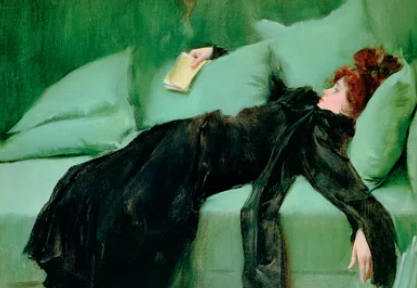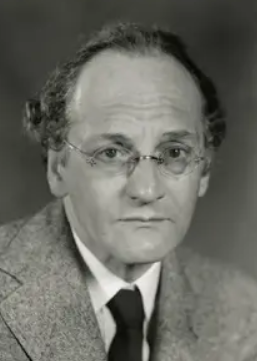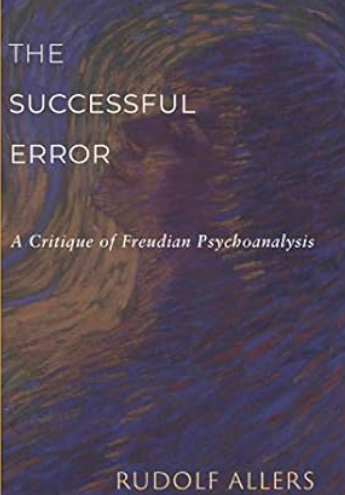
Rudolf Allers: Seeing Through Freud’s Errors

The novel use of the word psychoanalysis over a century ago by a then obscure Austrian neurologist, Sigmund Freud, sparked one of the most influential revolutions in human thought. The popularity of the word and Freud’s theories followed on from the publication of Studies in Hysteria in 1896, co-authored with Freud’s friend Joseph Breuer. Breuer’s “talking cure” impressed Freud, and Freud refers to Breuer’s great influence on him, although the partnership ended after the publication of this book.[1]
A century later, many psychologists still see Freud as a pioneer, and yet few realise how derivative and unscientific his ideas were. Simply excusing him by saying that he wrote “in the context of scientific knowledge of the day” won’t do, as Freud was not as scientifically rigorous as many of his peers. Saul Rozenzweig pointed out that though Freud had studied at the Bruke Institute, this “did not train him in the experimental methods employed by Fechner, Helmholtz and Wundt”[2]. Richard Webster in Why Freud Was Wrong (1996) says that, rather than representing any pioneering progress in science, Freudianism was a more “messianic” phenomenon, one of the most subtle of our many attempts to use reason in a “magical” rather than in a scientific manner.[3]
From Quadrant‘s archives.
Subscribers enjoy immediate access to all our content
Rozenzweig and Webster wrote after Freud’s heyday, later in the twentieth century. Did anyone, however, try to critique Freud at the time his ideas were gaining currency—while he was alive—who indeed knew Freud? Yes, indeed: one such challenger was the outstanding thinker and psychotherapist Rudolf Allers. Initially a disciple of Freud, in Freud’s last training course in Vienna, Allers later broke with him (along with Alfred Adler), because he had many questions which were unanswered.[4] Incidentally,  Viktor Frankl, the psychiatrist who survived Auschwitz, the creator of logotherapy, also became an ally of Allers after his own initial training in psychotherapy, and dedicated one of his books to him.[5]
Viktor Frankl, the psychiatrist who survived Auschwitz, the creator of logotherapy, also became an ally of Allers after his own initial training in psychotherapy, and dedicated one of his books to him.[5]
Allers (right) had a distinguished career, but few know of him and he is deserving of greater acknowledgment in the annals of Freudian critique. He was a physician, psychologist and philosopher who wrote and published around 600 books and papers. He was born in Vienna in 1883 and received his MD in 1906 from the University of Vienna. After practising medicine for two years, he studied to be a psychiatrist, coming under the influence of Freud. After working in psychiatric clinics, in 1913 he became instructor of psychiatry at the University of Munich. In the First World War he worked as a surgeon in the Austrian Army, and after the war he wrote a book about bullet wounds in the head. He had also worked in a biochemistry laboratory and wrote several papers on his experiments.
From 1918 to 1938 Allers specialised in psychiatry. From 1920 onwards he did psychotherapeutic consultations, lecturing and doing research at the medical school in Vienna, becoming the director of medical psychology there. He also went to the Sacro Cuore University in Milan, invited by the famous psychologist Father Agostino Gemelli, one of the founders of this great Catholic university, and Allers earned his doctoral degree there in philosophy in 1934. In 1938 he foresaw the perils of Hitler’s takeover of Austria, so he decided to accept an invitation to teach psychology at the Catholic University of America.
Allers came to disagree with what he describes as unscientific and philosophically untenable ideas of Freud. He said Freud’s views on human nature, while purporting to be scientific, were not so, but rather reflected a desire to find holistic explanations for the psychic operations of the human person, explanations that just did not work. He presented his perceptive critique in a relatively unknown book entitled The Successful Error: A Critical Study of Freudian Psychoanalysis. Published in 1940, his critique was a remarkable analysis of Freud’s ideas, from one who knew the scene well and had studied with Freud.
To place the rise of Freud in context, in his book Allers describes some of the cultural and intellectual atmosphere of late nineteenth century—what he terms the geistesgeschichtliche—saying that it “is unthinkable that Freud should not have been influenced by this intellectual atmosphere or should not have become acquainted with many of the ideas which were of interest to the circles in which he was moving”.[6] After Freud graduated in 1882, he went to Paris in 1885 to study with Jean-Martin Charcot, who is often referred to as the founder of modern neurology. One can put the case that this period propelled Freud away from medicine and into psychology. In a recent paper in Neurology, Oliveira et al state of Freud:
He was deeply impressed by Charcot’s teachings, and this period proved instrumental in the shift in his interest from general neurology to the study of hysteria, hypnosis, and other psychological issues. [7]
If Paris had a major influence, Vienna had an overwhelming one, with its feverish excitement and exchange of ideas at the turn of the twentieth century. This was a city, recalls Allers, where the physician Billroth was a friend of the musician Brahms, where newspapers reported intellectual and artistic news, where a new book by a famous author, however difficult, was expected to be known and discussed. [8]
It was a time “when to have read Schopenhauer was considered necessary for everyone who aspired to the name of a cultured person”—so much so, that society women carried a volume of Schopenhauer to peruse while their hair was done.[9] Religion, while viewed as a need of the masses, was not always despised, as there was an anthropological and cultural interest in religious issues. Physics was extolled “as if it were a new faith”, and along with the passion for analysing parts of the natural world, a desire arose for explanations that emphasised its continuities. Thus, Allers says, the theory of evolution was simply the result of applying the idea of continuity to the varieties of living organisms, and he adds, “one may look in the same manner also on psychoanalysis”.[10] While scientists examined discrete phenomena, there was an unfulfilled yearning for a total explanation of the mind, which would overcome disparateness, elementism and analysis.
While Freud often seemed original, Allers insists that many of his ideas were restatements of major thinkers of the day. He states that Freud often uses terms which had been originally pointed to by the scientist-philosopher Johann Friedrich Herbart in the earlier nineteenth century, especially “repression” and “inhibition’, the notions of “ideas pushing upwards from the unconsciousness into consciousness” and of “quantities of energy and of the relation of emotional states to the forces at work in the mind”.[11] Similarly, E.M. Thornton has more recently stated:
In 1914 the Polish psychologist Luise von Karpinska had pointed out the striking resemblance of Freud’s theories to those propagated seventy years before by Johann Freidrich Herbart … The system he taught was almost identical to that of Freud. He wrote of unconscious mental processes, of ideas being repressed from consciousness by opposing ideas and of the same kind of “forces” possessing specific quantities as had Freud.[12]
Freud himself does not refer to Herbart, but Allers proposes that Freud would have heard of such ideas through several channels, through his colleague Breuer, and through contemporary psychiatrists. One of Freud’s most influential biographers, Ernest Jones, who always sought to present his subject as an original thinker, also refers to a school textbook used in Freud’s last year in the Gymnasium—Gustav Adolf Lindner’s Lehrbuch der empirischen Psychologie nach genetischer Methode—which  Jones himself considers a compendium of the Herbartian psychology. It is difficult to put any case forward that Freud never encountered Herbart’s ideas, in fact quite the contrary, it is more likely that he absorbed them in the manner that many at the time did.
Jones himself considers a compendium of the Herbartian psychology. It is difficult to put any case forward that Freud never encountered Herbart’s ideas, in fact quite the contrary, it is more likely that he absorbed them in the manner that many at the time did.
Freud, like his contemporaries, would also have been challenged by Gustav Fechner, the founder of psychophysics, whose notions of “psychophysical parallelism” had their roots in the dualism of Descartes and Plato. The Aristotelian notion of the union of body and soul had fallen into demise, and Fechner stated that there was no causal relation between mental and physical phenomena and the body and mind exist in a pre-ordained psychophysical parallelism. Freud, like many around him, looked for some link between mental and physical phenomena and found it in the instincts. He explained the central role of instincts on the mind and body, uniting them, using the categories of science—efficient causality, energy, quantity, measurement and so forth. He also absorbed a current idea that there were invisible factors “inaccessible to immediate observation” which influence behaviour.[13]
The latter notion was greatly fuelled by Freud’s observation of the great psychiatrist-hypnotists of the day, Jean-Martin Charcot in Paris and Hippolyte Bernheim in Nancy. Freud saw them draw out knowledge hidden to the patients’ consciousness and formed the notion that to unveil the causal connections for current bodily and mental symptoms one had to return to the remote past of the individual—like digging through geological layers. Allers states that Freud discarded hypnosis, however, when he saw a hypnotised patient of Bernheim act out a command to hit him. When questioned repeatedly after the hypnosis as to why he had hit Bernheim, the patient recalled that Bernheim had asked him to do it under hypnosis. From this Freud understood that if you asked someone often enough, you could access the subconscious for causes of psychological malaise. The instincts were the link between all levels of the mind—the conscious, the subconscious and the unconscious—and hence explained psychic and somatic symptoms. Freud appeared to have found a unified explanation to the mind-body problem and the key to explaining psychic disorders and human behaviour.
Despite the neat continuities, however, Allers says that Freud was simply wrong. Freud presented his unified view as a “biological”, hence “scientific” explanation, saying that the instincts were like an energy needing constant discharge. These instincts create mental images of situations which promise immediate and full satisfaction of instinctual craving—and thus the instincts influence the psyche to achieve their ends. It is the psychotherapist’s task to unlock the link between the mental image and the instinct which drives it. This view, Allers points out, is impersonalistic and sees other people as “love objects”, a means of satisfying instincts and drives which must be satisfied. This ignores observable facts about the human person not being an “object” discharging energies, but as a being with the capacity for self-sacrifice and the disinterestedness of real love.
As Allers points out, there is no scientific basis for this explanation for an overriding force of impersonal instinct determining all human behaviour. Nor was there scientific evidence for the existence of an Oedipus complex, which Freud proposed as a key to human behaviour. In trying to strengthen the position of psychoanalysis by referring to mythology and ethnology, Freud had become:
… guilty of a very serious neglect of the prudence and the critical attitude a scientist is required to apply … the ideas he and his school cherish in regard to ethnology, prehistory, and culture are quite wrong and based on a rash acceptance of absolutely unfounded speculations.[14]
Even Freud’s friend and ally Erich Fromm took apart the “magical” explanation of the Oedipus complex in his work The Greatness and Limitations of Freud’s Thought (1979). [15] The history of psychology has done both Allers and Fromm a great injustice in not considering their superb accounts of how Freud greatly misunderstands the Oedipus story as the Greeks would have seen it. The Greek trilogy is more to do with man’s lack of knowledge of the consequences of what he is doing in a broader sense—in terms of fate.
This is how the story goes: Oedipus’s parents, Laius and Jocasta, are told by an oracle that if they have a son, he will kill his father and marry his mother. Horrifed, they abandon Oedipus at birth, binding his feet together in a distant forest. He is found, however, by a shepherd and given to the King of Corinth, who adopts him. Oedipus is told in turn that his fate is to kill his father and marry his mother and so he decides to avoid this fate by leaving Corinth. On the way he meets Laius, his father, and has an argument with him and ends up killing him in a fight. Then he goes to Thebes and, solving the riddle of the Sphinx, he is rewarded with the king’s widow as his wife and thus he marries Jocasta, his mother. After he reigns for some time, a plague falls on the city, and the blind seer Tiresias reveals that this plague is the punishment of the gods for the crimes of parricide and incest which Oedipus has committed. Oedipus is shocked, tries to hide from this truth, but in the end blinds himself when he is compelled to see it. Jocasta commits suicide. The tragedy ends at the point where Oedipus has suffered punishment for a crime which he committed unknowingly and despite his conscious effort to avoid committing it.
Not at any point in the story is there a Freudian “spin” of Oedipus being sexually attracted to his mother. If the theme is incest, why isn’t the attraction mentioned? To the Greeks incest would have been morally abhorrent, whereas Freud’s theory attempts to make the desire for an incestuous relationship between child and parent a “normal” infantile motivation—a great misunderstanding of the Greek play. Why did Freud not stick with the universal theme which pervades the drama—that we “see through a glass darkly”, that we sometimes cannot see the harmful consequences of our actions, and that there is a deceptiveness pervading earthly things?
Along with Fromm, Allers lays special focus on Freudian “interpretation” of dreams and how Freud mistook the symbol for the cause of the behaviour and often got the interpretation wrong, ignoring the universal or religious symbolism of many dreams. In fact, Freud avoided any religious accounts of behaviour, regarding religious thought as an obsessional neurosis. Given this rejection of Judeo-Christian thought, it is difficult to understand why so many Jews and Christians fell under Freud’s sway. In 1961 the American psychiatrist Hobart Mowrer observed that “as a profession, theologians are at the moment, it seems, more heavily under the sway of Freudian ideology than any other comparable group including psychologists and quite possibly, even psychiatrists”.[16] Mowrer decried the harm that Freudian psychology was producing in academic circles and popular culture, particularly in its misunderstanding of the central ideas of Christianity. He was one of a few lone voices, along with Allers and later Fromm, who “saw through” the pervasive hold of Freudian ideas and wrote about it at the time.
Categorising Freudian psychology as a material monism in which material and mental phenomena are, as it were, welded, Allers says, “None of his axioms and none of the leading methodological principles, can in fact be maintained unless it be against a background of an absolutely materialistic philosophy.”[17] In Freud’s thought, everything in the world of matter and in the realm of the mind is predetermined by the past because everything is linked to some precedent cause by the “despotic” rule of causality. In such a system, natural law, spiritual yearning and free will have no place, and the human being as envisioned by psychoanalysis is no more moral than infra-atomic particles.
As Allers recalls, any of Freud’s disciples who dared criticise psychoanalysis were accused of “resistance” by Freud and his inner circle. Any objection was explained by some unconscious instinct being resisted by the superego, which was not an inner moral sense, but more a Victorian type of social censor. There was no recourse to reasonable, logical questioning. Psychoanalysis had the key to all conflict and neuroses as a system and this led to astonishing explanations such as Paul Schilder’s “On the Psychoanalysis of Geometry, Arithmetic and Physics”, which argued that counting is based on divisibility, which is tearing things apart and thus part of the instinct of aggression and destruction. Thus are some mathematical pursuits explained![18] The Freudian passion for “reducing” any activity of the mind to primitive instinctive behaviour was a limitation that suppressed other possible interpretations.
While psychoanalysis grew, the research of more scientifically focused contemporaries such as Eugene Bleuler on schizophrenia, and Emile Kraeplin on the classification of mental disorders, tended not to gain as much attention, though these were worthy achievements at the time. Not to mention other pioneering psychologists at the time such as Father Verner Moore, a psychiatric researcher who developed a scale for understanding psychosis, and Albert Michotte, who outlined the philosophical bases to his experimental work, without conflating the two. There were many Freudian contemporaries who had discovered a fuller understanding of mental disorders at the time, who deserve to be better known.
Allers was perceptive in seeing, even in Freud’s heyday, that human behaviour is not based on biologically based instincts, that “values” do not arise out of needs, that life is not just one long opportunity to fulfil instinctual needs, and that people are not just “love objects”. It is extraordinary that Freud’s derivative and scientifically wrong ideas permeated entire halls of academe and indeed societies. It will take some psychoanalysis to explain how this pervaded nearly a century. How do intellectual cultures, societies and civilisations become enthralled by such erroneous views, which go against the observations of common sense?
This is perhaps the question of the twentieth century, driven by mass ideas, many leaving one field of destruction after another. After hindsight’s deconstruction of last century’s disastrous psychological and ideological worldviews, psychology has moved beyond the instinctual explanations of all behaviour and has increasingly acknowledged and articulated the transcendent dimension of the human person which can speak in a contemporary manner to a post-Freudian, post-Auschwitz world. We owe Rudolf Allers a great debt for being one of the first critics who saw through his era, and who challenged the seemingly unchallengeable Freudian monolith with reason, depth and psychological acuity.
Wanda Skowronska is a psychologist who lives in Sydney. She is the author of Catholic Converts from Down Under … And All Over (2016). She wrote on Paul Vitz (“The Psychologist Who Resisted the Cultural Onslaught”) in the September issue.
Endnotes
[1] Sigmund Freud, Five Lectures on Psycho-Analysis (UK: Penguin, 1995), 1–2, 10.
[2] Saul Rosenzweig,‘Freud and Experimental Psychology: The Emergence of Idiodynamics’. In Sigmund Koch and David E. Leary (eds.), A Century of Psychology as Science (New York: McGraw-Hill Book Company, 1985), 142.
[3] Richard Webster, Why Freud Was Wrong: Sin, Science and Psychoanalysis, (UK: HarperCollins, 1995).
[4] This is dealt with in Allers” book: Rudolf Allers, The Successful Error; A Critical Study Of Freudian Psychoanalysis (New York, Sheed & Ward, 1940).Henceforth Allers, SE
[5] Viktor Frankl, Psychotherapy and Existentialism: Selected Papers on Logotherapy (UK: Souvenir Press, 1970).
[6] Allers, SE , 225.
[7] Livia Oliveira, Helio Afonso Teive, Paula Marques, Francisco Germiniani, Luciano de Paola, “Jean-Martin Charcot’s influence on Sigmund Freud’s career’, Neurology, Apr 2018, 90 (15 Supplement), 309.
[8] Allers, SE , 225.
[9] Allers, SE , 225, 224. The description of the intellectual atmosphere of Vienna can be found in Chapter 11, 216 ff.
[10] Allers, SE, 219
[12] E.M.Thornton, The Freudian Fallacy: Freud and Cocaine (London: Paladin, 1986, 1983), 229 ff.
[13] Allers, SE, 230.
[14] Allers, SE, 120
[15] Erich Fromm, The Greatness and Limitations of Freud’s Thought (London: Jonathan Cape, 1980, 1979). See Chapter 3 for a critique of Freud’s theory of dream interpretation.
[16] Hobart O. Mowrer, The Crisis in Psychiatry and Religion (Princeton, US: D. Van Nostran, 1961), 134, 136.
[17] Allers, SE, 92.
[18] Schilder, Paul, “On the Psychoanalysis of Geometry, Arithmetic and Physics’, The Psychoanalytic Review (1913-1957), New York Vol. 26, (Jan 1, 1939): 563.
Madam: Archbishop Fisher (July-August 2024) does not resist the attacks on his church by the political, social or scientific atheists and those who insist on not being told what to do.
Aug 29 2024
6 mins
To claim Aborigines have the world's oldest continuous culture is to misunderstand the meaning of culture, which continuously changes over time and location. For a culture not to change over time would be a reproach and certainly not a cause for celebration, for it would indicate that there had been no capacity to adapt. Clearly this has not been the case
Aug 20 2024
23 mins
A friend and longtime supporter of Quadrant, Clive James sent us a poem in 2010, which we published in our December issue. Like the Taronga Park Aquarium he recalls in its 'mocked-up sandstone cave' it's not to be forgotten
Aug 16 2024
2 mins







